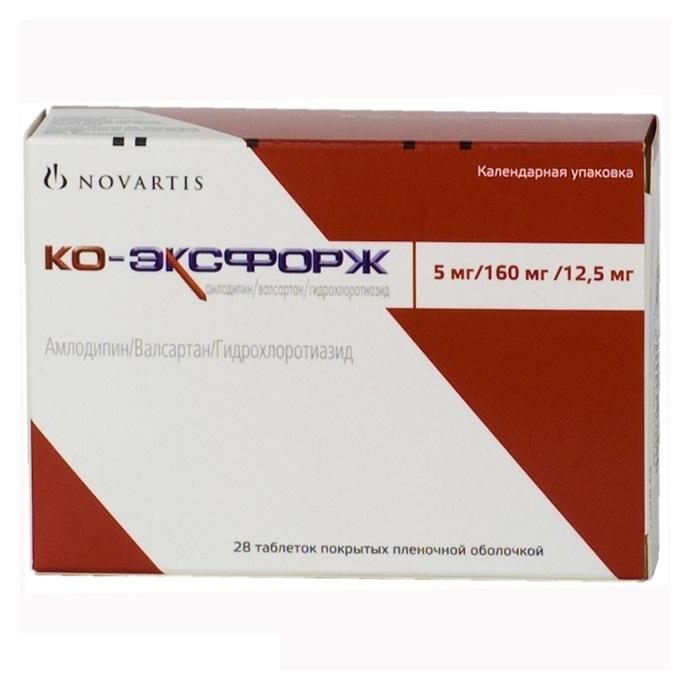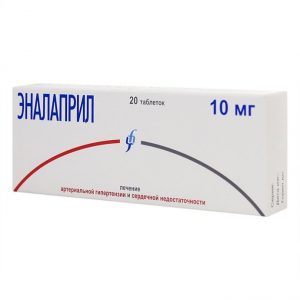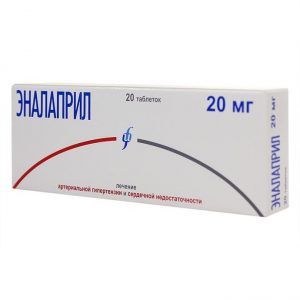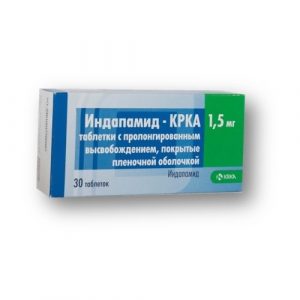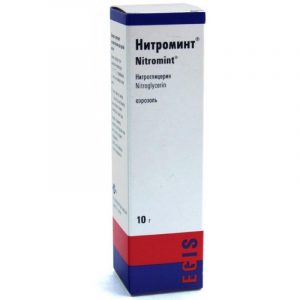Description
Release form
Tablets.
Packing
28 pcs.
Pharmacological action of
KO-EXFORGE is a combination of three antihypertensive components with a complementary mechanism of blood pressure control: amlodipine (a derivative of dihydropyridine), a slow calcium channel blocker, valsartan, an antagonist of angiotensin II receptors and antioxidants, tiazidiazidiazidia and iazidase. The combination of these components leads to a more pronounced decrease in blood pressure compared with that on the background of monotherapy with each drug separately.
Amlodipine
Amlodipine, a component of Co-Exforge, inhibits the transmembrane intake of calcium ions in cardiomyocytes and vascular smooth muscle cells. The mechanism of the antihypertensive effect of amlodipine is associated with a direct relaxing effect on vascular smooth muscle, causing a decrease in OPSS and a decrease in blood pressure.
After administration in therapeutic doses in patients with arterial hypertension, amlodipine causes vasodilation, leading to a decrease in blood pressure (in the patient s position, lying and standing). A decrease in blood pressure is not accompanied by a significant change in heart rate and catecholamine activity with prolonged use.
Plasma concentrations in the blood correlate with the therapeutic response in both young and elderly patients.
In arterial hypertension in patients with normal renal function, amlodipine in therapeutic doses leads to a decrease in renal vascular resistance, an increase in glomerular filtration rate and effective renal plasma blood flow without changing the filtration fraction and the severity of proteinuria.
As with other slow calcium channel blockers, while receiving amlodipine in patients with normal left ventricular function, a change in hemodynamic indicators of cardiac function at rest and during physical exertion was observed: a slight increase in the cardiac index, without significant effect on the maximum rate of increase in pressure in the left ventricle, on end-diastolic pressure and volume of the left ventricle . Hemodynamic studies in intact animals and healthy volunteers showed that a decrease in blood pressure under the influence of amlodipine in the range of therapeutic doses is not accompanied by a negative inotropic effect, even when used with beta-blockers.
Amlodipine does not alter the function of the sinoatrial node and does not affect AV conduction in intact animals and healthy volunteers. When using amlodipine in combination with beta-blockers in patients with arterial hypertension or with angina pectoris, a decrease in blood pressure is not accompanied by undesirable changes in electrocardiographic parameters.
Clinical efficacy of amlodipine in patients with stable angina pectoris, vasospastic angina pectoris and angiographically confirmed coronary artery disease has been proven.
In a lengthy placebo-controlled study (PRAISE-2) in patients with chronic heart failure (NYHA class III and IV functional class) of non-ischemic etiology, amlodipine increased the incidence of pulmonary edema, in the absence of significant differences in the incidence of worsening chronic heart failure versus placebo.
Risk of myocardial infarction or an increase in the severity of angina pectoris: rarely, with the initiation of therapy with slow calcium channel blockers or with an increase in their dose in patients, especially with hypertrophic obstructive cardiomyopathy, severe obstructive coronary artery disease, an increase in the frequency, duration and severity of angina attacks or develops myocardial infarction. Arrhythmia (including ventricular tachycardia and atrial fibrillation) has also been observed with slow calcium channel blockers. It was impossible to differentiate these undesirable effects from the natural course of diseases.
Valsartan
Valsartan is an active and specific angiotensin II receptor antagonist intended for oral administration. It acts selectively on AT1 subtype receptors, which are responsible for the effects of angiotensin II. An increase in the plasma concentration of unbound angiotensin II due to blockade of AT1 receptors under the influence of valsartan can stimulate unblocked AT2 receptors, which counteract the effects of stimulation of AT1 receptors. Valsartan does not have any pronounced agonistic activity against AT1 receptors. The affinity of valsartan for AT1 subtype receptors is approximately 20,000 times higher than for AT2 subtype receptors.
Valsartan does not inhibit ACE, which converts angiotensin I to angiotensin II and causes the destruction of bradykinin. Because when using angiotensin II antagonists, ACE inhibition and the accumulation of bradykinin or substance P do not occur, the development of a dry cough is unlikely.
In comparative clinical studies of valsartan with an ACE inhibitor, the incidence of dry cough was significantly lower (p
When treating patients with arterial hypertension with valsartan, there was a decrease in blood pressure, not accompanied by a change in heart rate.
The antihypertensive effect manifests itself within 2 hours in most patients after a single dose The maximum decrease in blood pressure develops after 4-6 hours. After taking valsartan, the duration of the hypotensive effect persists for more than 24 hours. a minimal decrease in blood pressure regardless of the dose taken is usually achieved within 2-4 weeks and is maintained at the achieved level during long-term therapy.Abrupt cessation of valsartan is not accompanied by a sharp increase in blood pressure or other undesirable clinical consequences. The use of valsartan in patients with chronic heart failure (NYHA class II-IV functional class) leads to a significant reduction in the number of hospitalizations for cardiovascular diseases (which is especially pronounced in patients not receiving ACE inhibitors or beta-blockers). When taking valsartan in patients with left ventricular failure (stable clinical course) or with dysfunction of the left ventricle after myocardial infarction, a decrease in cardiovascular mortality is noted.
Hydrochlorothiazide
The point of application of the action of thiazide diuretics is the distal convoluted renal tubules. When thiazide diuretics act on highly sensitive receptors of the distal tubules of the renal cortex, the reabsorption of sodium ions (Na +) and chlorine (Cl-) is suppressed. The suppression of the co-transport system Na + and ¡l , apparently, occurs due to competition for the sites of binding of ¡l ions in this system. As a result, the excretion of sodium and chlorine ions increases approximately equally. As a result of the diuretic action, a decrease in BCC is observed, as a result of which the activity of renin, the secretion of aldosterone, excretion of potassium by the kidneys and, consequently, a decrease in the potassium content in the blood serum increase.
Amlodipine + valsartan + hydrochlorothiazide
When using triple combination therapy with amlodipine + valsartan + hydrochlorothiazide, a more pronounced decrease in systolic and diastolic blood pressure was observed compared with the double combinations: valsartan + hydrochlorothiazide, amlodipidine + amlipidine + valine. In patients with arterial hypertension of the II and III degree (initial mean blood pressure of 170/107 mm Hg) when using the combination therapy of amlodipine + valsartan + hydrochlorothiazide in a daily dose of 10 mg + 320 mg + 25 mg for 8 weeks, the average decrease in systolic and diastolic blood pressure was 39.7 / 24.7 mm Hg (compared with 32.0 / 19.7 mm Hg, 33.5 / 21.5 mm Hg, 31.5 / 19.5 mm Hg in combination with valsartan + hydrochlorothiazide at a dose of 320 mg + 25 mg, amlodipine + valsartan at a dose 10 mg + 320 mg and amlodipine + hydrochlorothiazide at a dose of 10 mg + 25 mg, respectively).
The highest antihypertensive effect of the drug Co-Exforge is observed 2 weeks after the start of the drug in the maximum individual dose inside.
When using Co-Exforge, the achievement of the target blood pressure (less than 140/90 mm Hg) was observed in 71% of patients, compared with 45-54% on the background of the use of double combinations.
After taking the drug, the antihypertensive effect persists for 24 hours.
The therapeutic efficacy of Co-Exforge does not depend on the age, gender and race of the patients.
Contraindications
Hypersensitivity to amlodipine, valsartan, hydrochlorothiazide, another sulfonamide derivative, dihydropyridine derivative and other auxiliary components of the
preparation Pregnancy and the period of breastfeeding
Severe impaired liver function (more than 9 points on the Child-Pough scale)
Severe impaired function of the night (Cl creatinine less than 30 ml / min)
Refractory to adequate therapy hypokalemia, hyponatremia, hypercalcemia, as well as hyperuricemia with clinical manifestations
Age under 18 years of age (efficacy and safety have not been established).
Use during pregnancy and lactation
Contraindicated.
Special instructions
Impaired renal function
When using Co-Exforge, regular monitoring of plasma creatinine and potassium levels is necessary.
Cancellation of beta-blockers
If it is necessary to cancel beta-blockers before starting Co-Exforge therapy, the dose of beta-blockers should be reduced gradually. Since the composition of the drug Co-Exforge does not include beta-blocker, the use of the drug does not prevent the development of the withdrawal syndrome that occurs when the treatment with beta-blockers is abruptly stopped.
Marked decrease in blood pressure
In controlled studies using Co-Exforge at the maximum daily dose (10 mg + 320 mg + 25 mg) in patients with grade 1 and III hypertension. In 7% of cases, a marked decrease in blood pressure was observed, including orthostatic hypotension (compared with 1.8%, 0.4% and 0.2% in combination with valsartan + hydrochlorothiazide at a dose of 320 mg + 25 mg, amlodipine + valsartan at a dose of 10 mg + 320 mg and amlodipine + hydrochlorothiazide at a dose of 10 mg + 25 mg, respectively). In the event of the development of arterial hypotension, the patient should be laid with raised legs, if necessary, intravenously infuse 0.9% sodium chloride solution. After stabilization of blood pressure, treatment with Co-Exforge can be continued.
Hyponatremia and / or a decrease in bcc
In patients with activated RAAS (for example, deficiency of bcc and / or hyponatremia, as well as in patients receiving high doses of diuretics), antagonists of angiotensin receptors may develop symptomatic hypotension. Before starting treatment with Co-Exforge, a correction of the sodium content in the body and / or BCC should be carried out or therapy should be started under close medical supervision. When using Co-Exforge, regular monitoring of blood plasma electrolytes is necessary.
Change in plasma potassium concentration
In controlled trials with the combination of amlodipine + valsartan + hydrochlorothiazide at a maximum daily dose of 10 mg + 320 mg + 25 mg in patients with moderate and severe arterial hypertension, the incidence of hypokalemia (potassium in the blood plasma is less than 3.5 mmol / l) was 9.9% compared with 24.5%, 6.6% and 2.7% in combination with amlodipine + hydrochlorothiazide at a dose of 10 mg + 25 mg, valsartan + hydrochlorothiazide at a dose of 320 mg + 25 mg and amlodipine + valsartan at a dose of 10 mg + 320 mg, respectively. The frequency of discontinuation of therapy due to the development of hypokalemia was 0.2% (one patient) in the Co-Exforge and amlodipine + hydrochlorothiazide groups. In patients treated with Co-Exforge, hyperkalemia (potassium in the blood plasma of more than 5.7 mmol / l) was observed in 0.4% of cases (compared with 0.2-0.7% with double combinations). When using Co-Exforge in a controlled study, the opposite effects of valsartan at a dose of 320 mg / day and hydrochlorothiazide at a dose of 25 mg / day on potassium in the blood serum almost balanced each other in many patients. In other cases, patients had either hypo- or hyperkalemia. When using Co-Exforge, regular monitoring of potassium in the blood plasma is necessary.
Systemic lupus erythematosus
When using thiazide diuretics, including hydrochlorothiazide, an increase in the course or development of systemic lupus erythematosus has been reported.
Other metabolic disorders
Thiazide diuretics can interfere with glucose tolerance and increase plasma concentrations of cholesterol, triglycerides and uric acid.
When using thiazide diuretics, a decrease in calcium excretion is possible, leading to the development of moderate hypercalcemia. Severe hypercalcemia during therapy with Co-Exforge may indicate latent hyperparathyroidism.
Effect on the ability to drive vehicles and control mechanisms
Some side effects of the drug, including dizziness or visual impairment can adversely affect the ability to drive vehicles and perform potentially dangerous activities that require increased concentration of attention and speed of psychomotor reactions.
Composition of
Amlodipine besilate 6.94 mg, which corresponds to the content of amlodipine 5 mg, valsartan 160 mg, hydrochlorothiazide 12.5 mg.
Excipients: microcrystalline cellulose, crospovidone, colloidal silicon dioxide, magnesium stearate.
The composition of the film membrane: hypromellose, titanium dioxide (E171), macrogol, talc.
Dosage and administration
The drug should be taken orally (preferably in the morning), washed down with a small amount of water, regardless of food intake
, Patients receiving therapy with amlodipine, valsartan and hydrochlorothiazide in separate tablets, can be transferred to therapy with Co-Exforge containing the same doses of active components, as well as with insufficient control of blood pressure during dual combination therapy (valsartan + hydrochlorothiazide, amlodipine + valsartan and amlodipine + hydrochlorothiazide), patients can be transferred to triple combination treatment Co-Exforge in appropriate doses.
If a patient has dose-related side effects when using double combination therapy with any components of Co-Exforge, to achieve a similar decrease in blood pressure, patients may be prescribed Co-Exforge containing a lower dose of the active component that caused this side effect.
Recommended daily doses of Co-Exforge are:
– 5 mg + 160 mg + 12.5 mg (1 tablet, containing amlodipine + valsartan + hydrochlorothiazide in doses of 5 mg + 160 mg + 12.5 mg)
– 10 mg + 160 mg + 12.5 mg (1 tablet containing amlodipine + valsartan + hydrochlorothiazide in doses of 10 mg + 160 mg + 12.5 mg)
– 10 mg + 320 mg + 25 mg (2 tablets containing amlodipine + valsartan + hydrochlorothiazide in doses of 5 mg + 160 mg + 12.5 mg).
The maximum antihypertensive effect of the drug is observed 2 weeks after increasing the dose. The maximum dose of the drug is 10 mg + 320 mg + 25 mg /
In patients over 65 years of age, dose adjustment of the drug is not required.
Since the safety and effectiveness of Co-Exforge in children and adolescents (under 18 years of age) have not yet been established, the drug is not recommended for use in this category of patients.
In patients with mild to moderate impaired renal function (CC more than 30 ml / min) and liver (5-9 points on the Child-Pugh scale) dose adjustment is not required.
Side effects of
The following criteria were used to estimate the frequency (according to the WHO classification): very often (? 1/10) often (? 1/100,
from the metabolic side: often – hypokalemia infrequently – anorexia, hypercalcemia, hyperlipidemia, hyponatremia .
From the nervous system: often – dizziness, headache infrequently – insomnia / sleep disturbances, impaired coordination, postural dizziness and dizziness due to physical exertion, taste disturbances, lethargy, paresthesia, neuropathy, including peripheral, drowsiness, fainting.
From the sensory organs: infrequently – visual disturbances, vertigo.
From the cardiovascular system: often – a marked decrease in blood pressure infrequently – tachycardia, orthostatic hypotension, phlebitis, thrombophlebitis.
From the respiratory system: infrequently – cough, shortness of breath, sore throat.
From the digestive system: often – dyspepsia infrequently – discomfort in the abdomen, pain in the upper abdomen, bad breath, diarrhea, dry mouth, nausea, vomiting.
Dermatological reactions: infrequently – increased sweating, itching.
From the musculoskeletal system and connective tissue: infrequently – back pain, swelling in the joints, muscle cramps, muscle weakness, myalgia, pain in the limbs.
From the urinary system: often – pollakiuria infrequently – increased creatinine concentration in blood plasma, acute renal failure.
From the reproductive system: infrequently – erectile dysfunction.
On the part of the body as a whole: often – peripheral edema, increased fatigue infrequently – abasia, gait disturbances, asthenia, general weakness, pain in the chest area.
On the part of laboratory indicators: infrequently – increased plasma urea nitrogen, hyperuricemia, increased body weight.
overdose
There are currently no data on overdose cases.
With overdose of valsartan, a marked decrease in blood pressure and dizziness can be expected.
An overdose of amlodipine can lead to excessive peripheral vasodilation and possible reflex tachycardia. It was also reported that a pronounced and prolonged decrease in blood pressure up to the development of a lethal shock.
The main clinical manifestations of hydrochlorothiazide overdose are symptoms associated with loss of electrolytes (hypokalemia, hypochloremia) and dehydration due to stimulation of diuresis. The most common symptoms of overdose are nausea and drowsiness. Hypokalemia can be accompanied by muscle spasms. With concomitant use of cardiac glycosides (or other antiarrhythmic drugs), hypokalemia can increase cardiac arrhythmia.
Treatment: accidental overdose should induce vomiting (if the drug was recently taken) or wash the stomach. The use of activated charcoal in healthy volunteers immediately or 2 h after administration of amlodipine significantly reduced its absorption. In case of marked decrease in blood pressure, the patient should be lifted with his feet elevated, take active measures to increase blood pressure, maintain the activity of the cardiovascular system, including regular monitoring of cardiac and respiratory function, BCC and urinary output. In the absence of contraindications to restore vascular tone and blood pressure can be used (with caution) vasoconstrictor. In / in the introduction of solutions of calcium salts can be effective for eliminating calcium channel blockade. Withdrawal of valsartan and amlodipine during hemodialysis is unlikely. Hydrochlorothiazide can be removed from the systemic circulation by hemodialysis.
Storage Conditions
The product should be stored in a dry, out of the reach of children at a temperature not exceeding 25 ° C.
Shelf life
1,5 years.
Deystvuyushtee substance
Amlodipine, Valsartan, Gidrohlortiazid
Pharmacy terms
Prescription
dosage form
tablets
Possible product names
Novartis Pharmaceutica SA
Co. – exforge tab. n / a 5mg / 160mg / 12.5mg No. 28
KO-EXFORGE 0.005 + 0.16 + 0.0125 N28 TABLE P / O
KO-EXFORGE 5MG + 160MG + 12.5MG. No. 28 TAB. P / O
Co-Exforge 5mg + 160mg + 12.5mg Tab. p / pl / rev X28
Novartis Farma Stein AG, Switzerland
